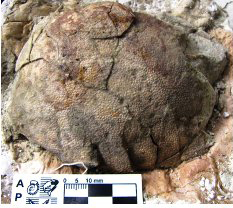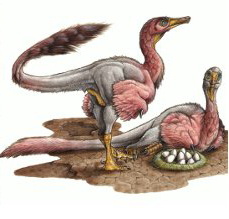Joint Swedish/Argentinian Research Team Report on Dinosaur Egg Discovery
A team of Swedish and Argentinian scientists have reported discovering the fossilised remains of a type of bird-like dinosaur in southern Argentina (Patagonia). In a first for South America, the fossilised hindlimb has been found in association with the pair of eggs, indicating that these eggs had not yet been laid when the female dinosaur which carried them met her end.
The eggs, with their pimple-like texture have been associated with the fossilised hindlimb and identified as being the eggs of a new type of bird-like dinosaur known as Bonapartenykus ultimus – classified as a type of alvarezsaurid.
Bonapartenykus ultimus
A Picture of the Fossilised Egg
Picture credit: Fernando Novas
The alvarezsaurids are one of the most bizarre groups of dinosaurs known to science. These fleet-footed, bipedal dinosaurs had compact bodies, long legs, long slender tails and narrow skulls. The arms and claws of these relatively small dinosaurs are unique amongst the Order Dinosauria. The humerus is relatively short but the ulna (one of the bones in humans between the elbow and wrist) is massive. The claw bone of the single digit is almost as big as the ulna. The fact that in most alvarezsaurids the enormous ulna projects well back from the elbow joint suggests very powerful leverage.
Scientists remain unsure as to what these strong, single-clawed arms were used for but it has been suggested that these dinosaurs could have broken into the nests of termites and other social insects just as the ant-eaters in South America do today.
Of all the known types of dinosaur, the alvarezsaurids have the most bird-like skeletons of all. The bird-like anatomical features include the specialised forelimbs, fused ankle bones, a prominent furcula (breast bone) and narrow skulls.
Fossils of these strange, cursorial dinosaurs are known from Argentina and from eastern Asia, indicating that this particular group of prehistoric animals had a wide geographic distribution. The earliest alvarezsaurid fossils date from the Late Cretaceous (90 million years ago), as these early alvarezsaurid fossils have been found in South America, it suggest that this group evolved in the Southern Hemisphere before radiating out northwards.
Bonapartenykus ultimus has been named and described based on the post-cranial fossil remains found at the dig site. The fossils come from the Allen Formation of the Río Negro in north-western Patagonia (Argentina). The fossils include dorsal vertebrae (back bones), pelvic bones and the hind limbs.
B. ultimus has been further classified into a new clade of alvarezsaurid termed the Patagonykinae – a family of South American alvarezsaurids that show anatomical characteristics mid-way between more primitive forms known from South America and advanced alvarezsaurids such as Mononykus olecranus known from Upper Cretaceous strata of Mongolia.
An Artist’s Illustration of Bonapartenykus ultimus
Picture credit: Gabriel Lio
Dinosaur Eggs
Commenting on this discovery, regarded as unique, Dr Martin Kundrát of Uppsala University (Sweden) stated:
“What makes the discovery unique are the two eggs preserved near articulated bones of the hindlimb. This is the first time the eggs are found in a close proximity to the skeletal remains of an alvarezsaurid dinosaur.”
The eggs were discovered in a joint Swedish/Argentinian expedition to the region in search of dinosaur fossils back in December 2010. The field team consisted of scientists from Sweden’s Uppsala University and the Museo Argentino de Ciencias Naturales.
At an estimated 2.6 metres long, B. ultimus is one of the largest dinosaurs of this type found to date. The fossilised remains also indicate that basal forms of the alvarezsaurid clade survived in Argentina to at least seventy million years ago, towards the end of the Cretaceous geological period.
Bonapartenykus ultimus represents the latest survivor of its kind known from landmass called Gondwanaland, the southern landmass in the Mesozoic Era, the researchers state. Despite the absence of skull material to help give the scientists a more accurate impression of what this dinosaur looked like, reconstructions have been made based on those fossils found and by comparing the remains to Patagonykus puertai – a closely related Alvarezsaurid from the Nequen Province of Argentina.
In a paper published in the scientific journal “Cretaceous Research” the scientists propose that the two eggs may have been inside the oviducts of the female when this animal died. Other finds of eggshells in the vicinity indicate that some eggs were incubated and contained embryos at a later stage of development. This find adds weight to the theory that unlike birds, which have just one oviduct, dinosaurs had two oviducts.
However, just like many birds, dinosaurs would have probably laid a clutch of eggs over several days. The eggs seem to be larger than hens eggs, with an estimated circumference of around twenty centimetres.
The eggs had a relatively rough, outer texture, a sort of pimple-like outer surface. A microscopic analysis of the fossilised eggs found in association with the hindlimb indicate that the eggs had been contaminated by fungi. This is the first instance recorded in the fossil record of fungal contamination of dinosaur eggs. It is likely that this contamination occurred after the female had died and the corpse had begun to rot out on the Cretaceous plain where this mother-to-be met her death.
For articulated models of dinosaurs including small theropods: Beasts of the Mesozoic Articulated Dinosaur Models.








Several artificial reservoirs can be observed near the joining of the rivers and in that areas one can see those interesting things.